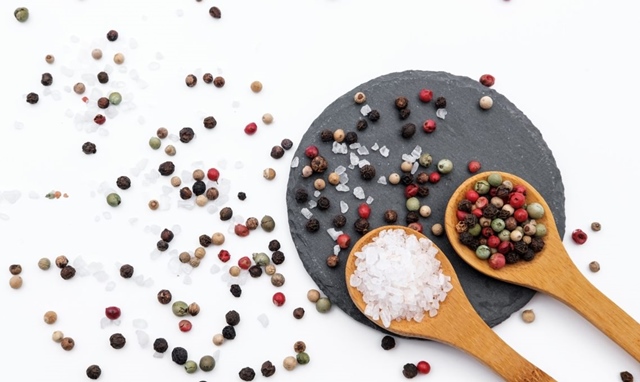
How to Season to Taste and Balance Flavours
In this post ...

A common, almost obligatory, instruction in recipes is “season to taste” but this is quite a broad direction and I am often asked …
What does season to taste mean?
Well, I looked it up on Merriam-Webster and according to them it means …
“to add as much salt or pepper or as much of a spice or herb as one
likes so something tastes good”
What a surprise – although I might add acid, sugar and a few more, see below, to this definition. Being able to season a dish properly is one of the most important skills of a chef so here’s some guidance.
For most of my cooking life (quite a long while, actually) it has been generally accepted that there are 5 basic flavours that we can taste;
Salty * Sweet * Sour * Bitter * Umami
Recently, it has been suggested that we humans can identify other tastes; fat and pungent and/or astringent, but I am not going to deal with these here, probably soon though!
Seasoning with Salt
Salt is amazing stuff, not only does it make food taste, umm … salty, it can also bring out the sweetness of a dish (think salted caramel – yum!) and it can even reduce bitterness, as in when you add a pinch of salt to coffee. You do that don’t you? If not give it a try!
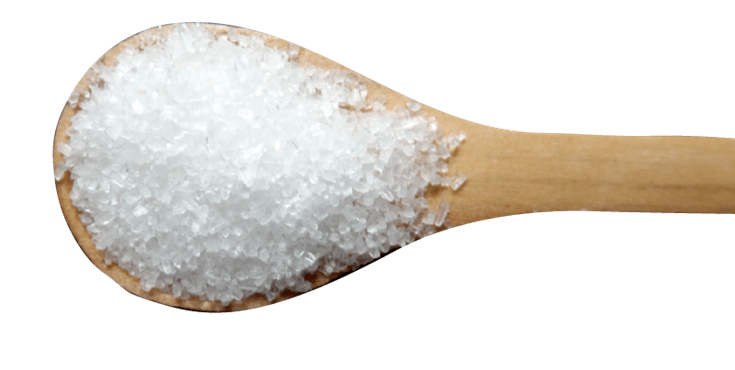
Which salt to use?
When I am salting potatoes for boiling, seasoning a sauce or adding a pinch to my coffee I use table salt. When I am seasoning meat or adding a sprinkle to a finished dish, I normally use Maldon sea salt. In the US kosher salt, which is similarly flaky, is frequently used.
Salty ingredients to balance a dish include …
~ Olives
~ Capers
~ Anchovies
~ Prosciutto/parma ham (prosciutto butter is a great way to add salt to a dish)
~ Salty cheese such as Feta
~ Soy sauce
Salt can be added at different times whilst preparing a dish …
Salting Before Cooking
Adding salt at the start of cooking has a different effect than salting at the end; it infuses the whole dish. Two ways to add salt at the beginning are add salt to water when cooking vegetables, pasta, rice etc. and sprinkling salt onto something to be cooked over dry heat such as meat or fish. Although salt is known to draw juices out of meat (and anything else) salting immediately before cooking is nevertheless a good thing, it adds flavour and doesn’t have time for any juice-drawing so salt before roasting, frying etc.
Interestingly enough, if you salt large pieces of meat long enough in advance the salt will indeed draw out some of the juices, but they will then be reabsorbed right into the centre of the meat thus seasoning the inside!! Rub a spoonful of sea salt into a joint of meat and leave for 4 or more hours before cooking. Smaller cuts of meat, duck breast for instance or steak, will benefit in the same way from salting say 20 minutes for the duck breast or 40 for a steak, before cooking. Wipe the meat surface before continuing so that you get a good sear and see here for how to make a delicious pan sauce from browned meat juices.
Salting During Cooking
If you add something new to the dish such as cream, stock, or anything really, add a little more salt.
Salting After Cooking
Once cooked, whatever it is, season “to taste” thus ~ taste, add a little salt, taste, add another pinch of salt, taste again, repeat till it is delicious. You are not aiming for a saltier taste but a brighter one with the sweet and bitter elements balanced out by the salt. Repeat till the food tastes exactly how you like it!
Most people have salt and pepper on the table when serv1ing so diners can also make small adjustments.

Seasoning with Sweetness
At first it might seem strange seasoning savoury foods with sweet ingredients, but a touch of sugar can give a real boost. Consider the many table sauces we use with savoury foods which contain high levels of sugar – mint sauce, tomato ketchup, sweet chilli sauce etc. Caramelised onions are gorgeous in many savoury dishes.
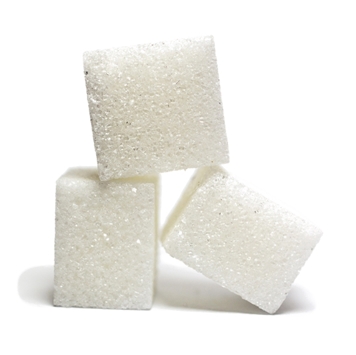
Adding just a little sugar makes salty things taste less salty and sour things taste less sour – a little brown sugar can be great in beef dishes see this recipe for Korean Bulgogi and sugar or a sweet ingredient such as tomato ketchup makes a tomato based dish even lovelier.
Sugar is the obvious sweet ingredient here but choose appropriately; dark brown sugar goes well with beef and gives a caramel taste, light brown sugar is a bit butterscotchy, white sugar is probably the best all purpose taste.
Sweet ingredients to balance a dish include …
~ Sugar
~ Honey
~ Maple syrup
~ Jam
~ Fruits – sweet ones, not citrus, cranberry or pineapple
~ Dried fruits
~ Caramelised onions
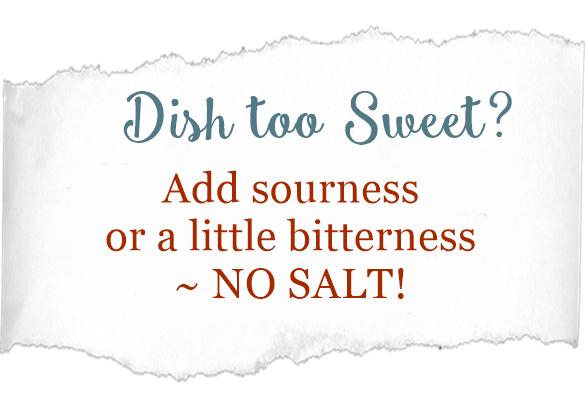
Seasoning with Sourness or Bitterness
Oddly enough, if a meal is too sweet don’t try to balance it by adding salt – as I said above salt can make things taste sweeter. Instead add a squeeze of lemon or lime or a dash of vinegar as appropriate.
Seasoning with Sourness
Squeezing lemon juice into a dish to balance out sweetness or spicyness A dash of citrus juice or vinegar can really brighten a dish, in fact if you are nervous about too much salt when tasting and seasoning try a squeeze of lemon. It will also balance out too much sweetness or spiciness.

Sour ingredients to balance a dish include …
~ Lemon and lime juice
~ Canned tomatoes (fresh too but not so much)
~ Vinegar – lots to choose from so select one that goes with what you are cooking!
~ Sour cream and buttermilk
~ Tamarind paste
Seasoning with Bitterness
Bitter flavours can be used to balance rich or over-sweet dish for instance a dash of coffee in a sweet chocolate dessert.
Bitter ingredients for balancing a dish include …
~ Coffee
~ Unsweetened cocoa and very dark chocolate
~ Citrus peels
~ Olives
~ Grapefruit
~ Horseradish.
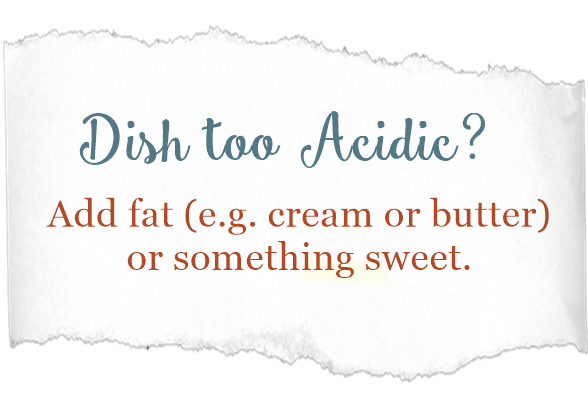
OR …
Sift over a little bicarbonate of soda (baking soda) wait till the bubbling stops and stir in. Taste. If it needs a little more repeat.
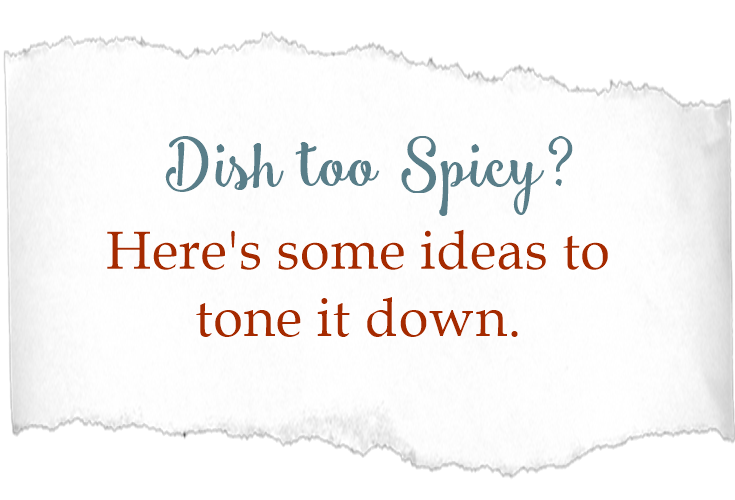
Coping with an Over Spiced Dish
The first and important thing to do is to stop panicking. Here are some more suggestions …
~ Add a little more of a bland ingredient; more liquid for instance or a starchy ingredient such as potatoes.
~ Add a little of something sweet, tomato ketchup will work if suitable to the dish, as will sugar, honey, etc. Add a little at a time tasting as you go – in short “season to taste”!
~ In Thailand lemon or lime juice is used to counteract too much spice and it also adds a little more flavour to the dish.
~ A creamy ingredient can help, coconut milk is a good idea and is appropriate in Asian dishes. Or top the meal with a spoonful of plain yogurt (also appropriate in Asian dishes) or sour cream (chillies and other South American meals).
~ Not quite seasoning but a good idea with an over-spiced dish is to serve it with something seriously bland and starchy such as potatoes, rice, pasta or bread.
Seasoning with Umami/Savourines
Umami is apparently Japanese for “delicious savoury taste” which was identified as a basic taste by Professor Kikunae Ikeda in 1908 but it seems to have been some while before we adopted the word. I was happy with savoury! I’m not going to go into details here, but it is something to do with glutamate.
Savoury ingredients add depth to your food.
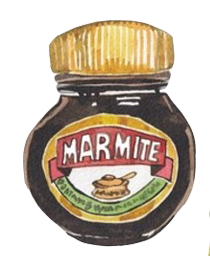
Umami rich ingredients include …
~ Marmite (apologies to American readers, didn’t mean to frighten you!)
~ Soy sauce
~ Parmesan cheese, Blue cheese & Cheddar cheese
~ Mushrooms generally and dried shiitake mushrooms in particular
~ Anchovies
~ Worcestershire Sauce – because it contains anchovies
~ Dry-cured ham
~ Tomatoes
~ Oyster sauce
~ Miso
~ Beef broth
… and I think reading this list you can imagine the type of taste I am referring to. If you add one or more of these ingredients, as appropriate of course, to your cooking you will give it a real flavour boost.
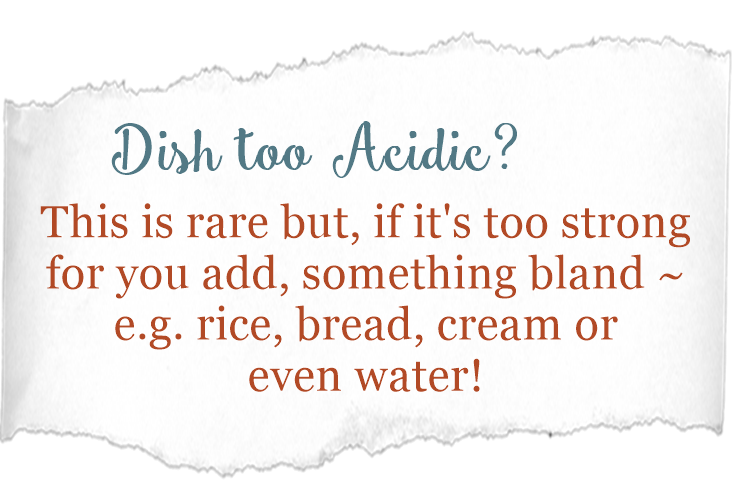
Important when Seasoning Dishes to be served Chilled
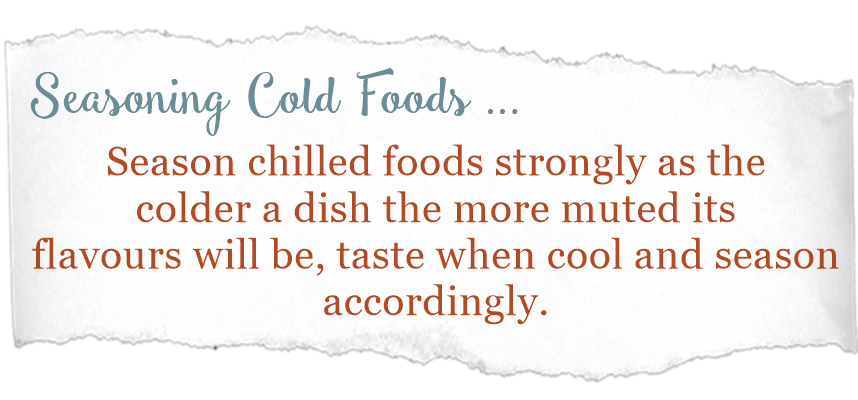
Suzy Bowler
Having been a somewhat itinerant chef for over 30 years I was amazed, on my return to the UK, at the blatant food waste that now seems to be rife in the country; amazed and irritated. So much so that I decided to start a blog about spontaneous cooking from leftovers to show people that there are great alternatives to throwing food away.

